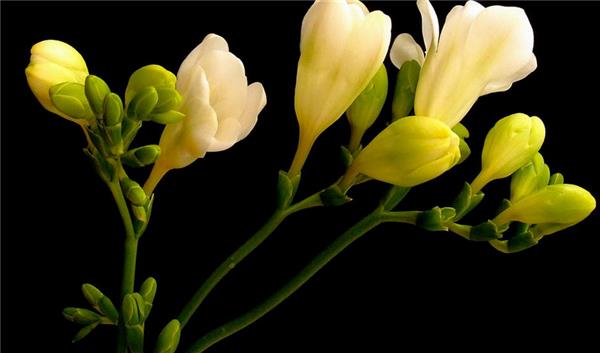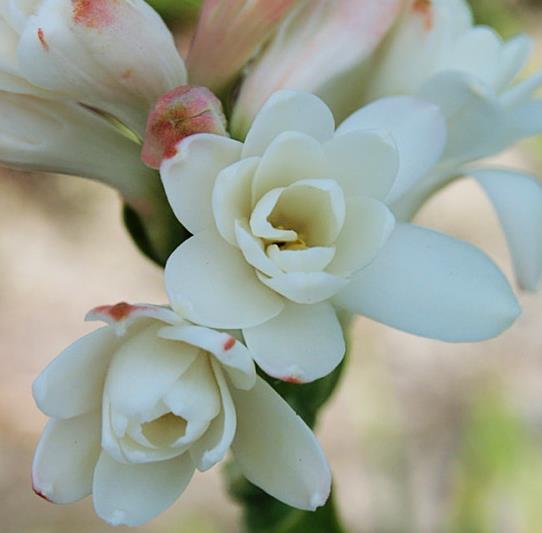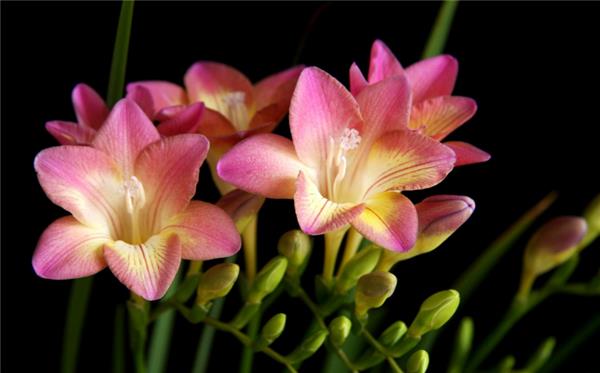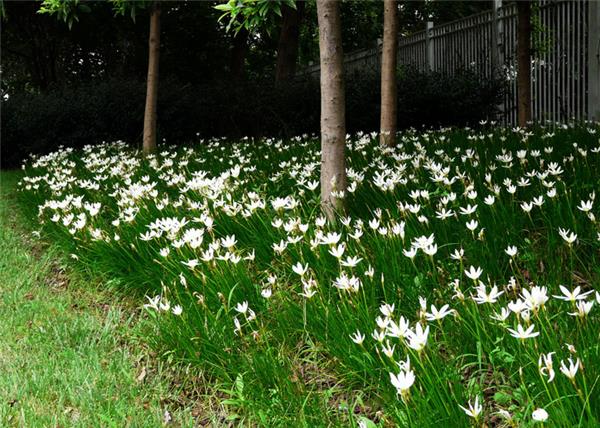Introduction and breeding method of Queen Evening Xiangyu at Night
Late fragrant jade is one of the most important cut flowers because of its strong fragrance, slender stems, soft lines, easy planting and flowering regulation, and is the main flower arrangement in bouquets and flower arrangements. now take a look at the knowledge of evening fragrant jade.

1. Introduction of Evening Xiangyu
Evening fragrant jade is a perennial bulbous flowering plant of the genus Amaryllidaceae (or tequila). Perennial herbs, rhizomatous tufts; linear leaves clustered, apex pointed; longer flower stems, upper racemes, white flowers in summer and autumn, strong fragrance, more fragrant at night. The evening jade flower blossoms at night. In eastern India, it is called "Ratkirani", which means "queen of the night". The florescence of open field planting is usually from early July to early November, while the full flowering period is from August to September, which is a summer cut flower species.

Second, the morphological characteristics of late fragrant jade.
Evening fragrant jade, also known as night incense, moon incense. Belongs to Amaryllidaceae winter dormant bulb plant, perennial bulb flowers. About 80 cm high, bulb bulb tuberous (the upper part is bulbous, the lower half is tuberous). The spike-shaped bouquet is terminal, with 12-32 flowers per panicle, white funnel-shaped flowers with strong fragrance, more fragrant at night, hence the name. The florescence of open field planting is usually from early July to early November, while the full flowering period is from August to September, which is a summer cut flower species. About 80 cm high, leaves basal, lanceolate, base slightly reddish, cauline leaves short. Spikes, with pairs of 12-18 flowers, blooming one after another from the bottom up, white flowers, funnel-shaped, fragrant, thicker at night, hence the name Yilaixiang. Scape erect, 40-90 cm high; flowers opposite, white, arranged in long spikes, with strong fragrance, stronger aroma at night; perianth tube slender, lobes 6, shorter than perianth tube; double varieties, light flower fragrance, florescence from July to October. The fruit is a capsule, late fragrant jade self-pollination, but because the pistil maturity is later than the stamen, so the natural seed setting rate is very low, generally not fruiting under cultivation. Open from May to November. Capsule. There are two kinds of cultivated varieties: White flower and lavender: most of the white flowers are single with strong fragrance, and most of the lavender flowers are double, with about 40 flowers per inflorescence. Dormant bulbous plants in winter, evergreen in origin, bulbous bulbous (bulbous in the upper part and tuberous in the lower half).

Third, the cultivation techniques of late fragrant jade.
The bulbs are usually planted from April to May, and the bulbs are replanted after 10-15 days of wet treatment at 25 ℃-30 ℃. Big and small balls and old balls that bloomed last year (commonly known as "old disabled") should be planted separately. The row spacing of large bulbs is 20 × 25 cm (or 30 cm), and that of small bulbs is 10 × 15 cm or denser, and the planting depth should be slightly shallower than that of other bulbs, but it also varies according to the purpose of cultivation, soil properties and the size of bulbs. Usually "deep long ball, shallow scape", that is, deep planting is conducive to the growth and expansion of the sphere, shallow planting is conducive to flowering. Generally, it is appropriate to plant a big ball with the bud top slightly exposed to the ground, and when planting small balls and "remnants", the bud top should be lower than or flush with the soil surface. The emergence of late fragrant jade is slow, which takes more than one month, but it grows faster after emergence. Therefore, in the early stage of planting, due to small seedlings and few leaves, there is no need to irrigate too much; when the flowering stem is about to be drawn out and in the early stage of flowering, we should fully irrigate and often keep the soil moist. Late fragrant jade likes fertilizer, should often apply topdressing: generally apply once after one month of planting, once before flowering, and then every one and a half or two months, pay attention to drainage and flower stem lodging in the rainy season. Dig out the bulb root before frost at the end of autumn, dry it slightly, remove the soil and fibrous root, and cut off a thin layer at the bottom of the ball to reveal white; continue to dry, and then braid the remaining leaves and hang them in a warm and dry place for storage for the winter. Or use the method of stove baking, hang the bulb root in the room and put the stove below to bake it. The initial room temperature was kept at 25 ℃-26 ℃, the moisture in the sphere was gradually reduced to the dry wrinkle of the outer skin, and the temperature decreased to 15 ℃-20 ℃ until it came out of the house in the next spring. After baking, the sphere can be fully dried, thus forcing it to dormancy completely, which is beneficial to the growth and flower bud differentiation after planting in the next spring. There are also bulbs that are dried and stacked in a dry sunny cellar, covered with straw and soil in layers and pressed, buried through the winter, or dug up and replanted after continuous planting for 2-3 years, but the flowering quality is poor and the florescence is irregular.
1. Cultivation and management
The planting land should be prepared and fertilized, and the big ball, the small ball and the old ball that had flowered last year should be planted separately. The distance between big bulbs and small ones is 25 and 10 meters, respectively. The depth of planting ball is shallower than that of other bulbs, it is appropriate for the big ball to slightly expose the soil surface at the top of the bud, and the top of the small ball and the old ball should be lower than the soil surface. the old ball blossomed last year and can no longer blossom, only growing many thin and pointed balls around the old ball. "Deep long ball, shallow scape" is the principle followed by the depth of late fragrant jade planting ball. At the initial stage of planting, because there are few leaflets, there is no need for too much water; when the scape is about to be extracted, it should be given sufficient water and topdressing fertilizer; only when the scape is extracted can it be topdressing with thicker liquid fertilizer. Summer should pay attention to watering and always keep the soil moist. After the aboveground part has withered, leaves or hay are often used to cover it to prevent freezing in the south of the Yangtze River, overwintering in the open field. But it is best to dig up the bulbs, dry them slightly, remove the soil, braid the residual leaves, continue to air until dry, hang them in a warm and dry place and store them over the winter at room temperature for more than 4 ℃. Late fragrant jade can also be potted, and potted plants can be used to promote cultivation. Planting balls in late November and cultivating them in a high-temperature greenhouse can blossom ahead of time from April to May, but it is not convenient for families to grow flowers.

two。 Matters needing attention
Fertilization: late fragrant jade likes fertilizer, should often apply topdressing: generally apply once after one month of planting, once before flowering, and then every one and a half or two months, pay attention to drainage and flower stem lodging in the rainy season. Dig out the bulb root before frost at the end of autumn, dry it slightly, remove the soil and fibrous root, and cut off a thin layer at the bottom of the ball to reveal white; continue to dry, and then braid the remaining leaves and hang them in a warm and dry place for storage for the winter. Or use the method of stove baking, hang the bulb root in the room and put the stove below to bake it.
Maintenance: "deep long ball, shallow scape" is the principle followed by the depth of late fragrant jade planting ball. At the initial stage of planting, because there are few leaflets, there is no need for too much water; when the scape is about to be extracted, it should be given sufficient water and topdressing fertilizer; only when the scape is extracted can it be topdressing with thicker liquid fertilizer. Summer should pay attention to watering and always keep the soil moist. After the aboveground part has withered, leaves or hay are often used to cover it to prevent freezing in the south of the Yangtze River, overwintering in the open field. But it is best to dig up the bulbs, dry them slightly, remove the soil, braid the residual leaves, continue to air until dry, hang them in a warm and dry place and store them over the winter at room temperature for more than 4 ℃. Late fragrant jade can also be potted, and potted plants can be used to promote cultivation. Planting balls in late November and cultivating them in a high-temperature greenhouse can blossom ahead of time from April to May, but it is not convenient for families to grow flowers.
The above is the knowledge of Evening Xiangyu. I hope I can help you.
Summer should pay attention to watering and always keep the soil moist. After the aboveground part has withered, leaves or hay are often used to cover it to prevent freezing in the south of the Yangtze River, overwintering in the open field. But it is best to dig up the bulbs, dry them slightly, remove the soil, braid the residual leaves, continue to air until dry, hang them in a warm and dry place and store them over the winter at room temperature for more than 4 ℃. Late fragrant jade can also be potted, and potted plants can be used to promote cultivation. Planting balls in late November and cultivating them in a high-temperature greenhouse can blossom ahead of time from April to May, but it is not convenient for families to grow flowers.

two。 Matters needing attention
Fertilization: late fragrant jade likes fertilizer, should often apply topdressing: generally apply once after one month of planting, once before flowering, and then every one and a half or two months, pay attention to drainage and flower stem lodging in the rainy season. Dig out the bulb root before frost at the end of autumn, dry it slightly, remove the soil and fibrous root, and cut off a thin layer at the bottom of the ball to reveal white; continue to dry, and then braid the remaining leaves and hang them in a warm and dry place for storage for the winter. Or use the method of stove baking, hang the bulb root in the room and put the stove below to bake it.
Maintenance: "deep long ball, shallow scape" is the principle followed by the depth of late fragrant jade planting ball. At the initial stage of planting, because there are few leaflets, there is no need for too much water; when the scape is about to be extracted, it should be given sufficient water and topdressing fertilizer; only when the scape is extracted can it be topdressing with thicker liquid fertilizer. Summer should pay attention to watering and always keep the soil moist. After the aboveground part has withered, leaves or hay are often used to cover it to prevent freezing in the south of the Yangtze River, overwintering in the open field. But it is best to dig up the bulbs, dry them slightly, remove the soil, braid the residual leaves, continue to air until dry, hang them in a warm and dry place and store them over the winter at room temperature for more than 4 ℃. Late fragrant jade can also be potted, and potted plants can be used to promote cultivation. Planting balls in late November and cultivating them in a high-temperature greenhouse can blossom ahead of time from April to May, but it is not convenient for families to grow flowers.
The above is the knowledge of Evening Xiangyu. I hope I can help you.
- Prev

Introduction and Culture methods of Dragon Boat Flowers how to grow beautiful Dragon Boat Flowers
Introduction and Culture methods of Dragon Boat Flowers how to grow beautiful Dragon Boat Flowers
- Next

Introduction and cultivation skills of bowl lotus how to cultivate graceful bowl lotus
Introduction and cultivation skills of bowl lotus how to cultivate graceful bowl lotus
Related
- Wuhan Hospital Iron Tree Blooming Result Was Instantly Frightened by the Gardener Master
- Which variety of camellia is the most fragrant and best? Which one do you like best?
- What is the small blue coat, the breeding methods and matters needing attention of the succulent plant
- Dormancy time and maintenance management of succulent plants during dormancy
- Minas succulent how to raise, Minas succulent plant pictures
- What are the varieties of winter succulent plants
- How to raise succulent plants in twelve rolls? let's take a look at some experience of breeding twelve rolls.
- Attention should be paid to water control for succulent plants during dormant period (winter and summer)
- Watering experience of twelve rolls of succulent plants
- Techniques for fertilizing succulent plants. An article will let you know how to fertilize succulent plants.

